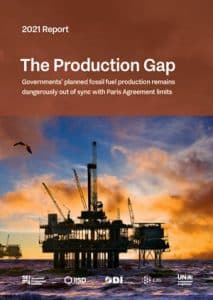
 The Production Gap Report, published jointly by the United Nations Environmental Program and several major environmental research institutions, tracks the discrepancy between governments’ planned fossil fuel production and global production levels consistent with limiting warming to 1.5°C or 2°C.
The Production Gap Report, published jointly by the United Nations Environmental Program and several major environmental research institutions, tracks the discrepancy between governments’ planned fossil fuel production and global production levels consistent with limiting warming to 1.5°C or 2°C.
Below, slightly abridged, is the Executive Summary of the recently released 2021 report. The full report can be downloaded here (pdf).
Key Findings
- Governments plan to produce more than twice the amount of fossil fuels in 2030 than would be consistent with limiting warming to 1.5°C. The production gap has remained largely unchanged since our first analysis in 2019.
- Global fossil fuel production must start declining immediately and steeply to be consistent with limiting long-term warming to 1.5°C.
- Most major oil and gas producers are planning on increasing production out to 2030 or beyond, and several major coal producers are planning on continuing or increasing production.
- G20 countries have directed more new funding to fossil fuels than clean energy since the beginning of the COVID-19 pandemic.
- International public finance for the production of fossil fuels from G20 countries and multilateral development banks (MDBs) has significantly decreased in recent years.
- Governments have a primary role to play in closing the production gap and in ensuring that the transition away from fossil fuels is just and equitable.
This report first introduced and quantified the “production gap” in 2019, finding that the world’s governments planned to produce far more fossil fuels than consistent with their Paris Agreement commitment to limit global warming. Two years on, with the climate crisis clearer and more urgent than ever, governments continue to bet on extracting far more coal, oil, and gas than is consistent with agreed climate limits.
Specifically, this report’s production gap analysis — the first full update since 2019 — finds that the world’s governments still plan to produce more than double the amount of fossil fuels in 2030 than would be consistent with limiting global warming to 1.5°C, and 45% more than consistent with limiting warming to 2°C. Collectively, although many governments have pledged to lower their emissions and even set net-zero targets, they have not yet made plans to wind down production of the fossil fuels that, once burned, generate most of those emissions.
The latest Intergovernmental Panel on Climate Change report issued an important call to action: we are running out of time to limit long-term global warming to 1.5°C or even 2°C. This report shows that doing so requires steep and sustained reductions in fossil fuel production and use. The world’s governments must take urgent action to close the production gap.
The report’s main findings are as follows:
As countries set net-zero emission targets, and increase their climate ambitions under the Paris Agreement, they have not explicitly recognized or planned for the rapid reduction in fossil fuel production that these targets will require. Rather, the world’s governments plan to produce more than twice the amount of fossil fuels in 2030 than would be consistent with limiting warming to 1.5°C. The production gap has remained largely unchanged since our first analysis in 2019.
Since the release of the first Production Gap Report in 2019, many governments have announced new, more ambitious greenhouse gas (GHG) emission reduction targets, including net-zero pledges. While this is a positive development, only a few fossil-fuel-producing countries have begun to grapple with how zeroing out global GHG emissions will affect their future coal, oil, and gas production.
According to our assessment of recent national energy plans and projections, governments are in aggregate planning to produce 110% more fossil fuels in 2030 than would be consistent with limiting global warming to 1.5°C, and 45% more than would be consistent with limiting warming to 2°C, on a global level. By 2040, this excess grows to 190% and 89%, respectively.
Collectively, governments are planning and projecting production levels higher than those implied by their emission reduction goals, as announced in their nationally determined contributions (NDCs) under the UN climate process and other climate policies as of mid-2020.
Global fossil fuel production must start declining immediately and steeply to be consistent with limiting long-term warming to 1.5°C.
However, governments are collectively projecting an increase in global oil and gas production, and only a modest decrease in coal production, over the next two decades. This leads to future production levels far above those consistent with limiting warming to 1.5°C or 2°C.
The production gap is widest for coal in 2030: governments’ production plans and projections would lead to around 240% more coal, 57% more oil, and 71% more gas than would be consistent with limiting global warming to 1.5°C.
Compared to global production levels under the 2°C-consistent pathways, governments’ production plans and projections would lead to 120% more coal, 14% more oil, and 15% more gas in 2030. The production gaps for all fuels grow much wider by 2040 under both temperature limits.
This disconnect could be even worse than our analysis implies. As explored in Chapter 2, our estimate of the size of the production gap depends on model assumptions and conceptions of how the low-carbon transition unfolds, such as how much carbon dioxide can be captured and stored or sequestered, and the trade-offs among different emission-reduction strategies. If carbon dioxide removal technologies fail to develop at large scale, or if methane emissions are not rapidly reduced, the production gap would be wider than estimated here. Furthermore, Chapter 2 shows that minimizing methane emissions from fossil fuel extraction and distribution alone is not a substitute for a rapid wind-down in fossil fuel production itself.
G20 countries have directed nearly USD 300 billion in new funds towards fossil fuel activities since the beginning of the COVID-19 pandemic — more than they have toward clean energy. In contrast, they have significantly decreased new international public finance for fossil fuel production in recent years; multilateral development banks (MDBs) and G20 development finance institutions (DFIs) holding a total of over USD 2 trillion in assets have adopted policies that exclude fossil fuel production activities from future finance.
The trajectory of fossil fuels will be shaped by the unprecedented levels of investment that many governments are now injecting into their economies, as part of their COVID-19 recovery efforts. Since January 2020, G20 countries have directed USD 297 billion of new public financial commitments towards fossil-fuel-consuming and -producing activities. Though governments have begun to shift more of their COVID-19 recovery spending to clean energy, they still spend more on support for fossil fuels.
While international public finance institutions continue to support fossil fuel extraction, distribution, and processing, there are promising trends: new public finance for the production of fossil fuels from MDBs and G20 countries has significantly decreased since 2017, and, increasingly, MDBs and G20 DFIs have policies that exclude future investment in these activities.
This report details the government strategies, support, and plans for fossil fuel production in 15 major producer countries. Most major oil and gas producers are planning on increasing production out to 2030 or beyond, while several major coal producers are planning on continuing or increasing production.
This report provides country profiles for Australia, Brazil, Canada, China, Germany, India, Indonesia, Mexico, Norway, Russia, Saudi Arabia, South Africa, the United Arab Emirates, the United Kingdom, and the United States. The profiles summarize each country’s stated national climate ambitions; available information on government views, projections, and support for fossil fuel production; and emerging policies and discussions towards a managed and equitable wind-down of production.
These countries have announced GHG emission reduction targets through their NDCs and, in some cases, have set net-zero goals. However, few have assessed, at least publicly, whether their projected fossil fuel production is consistent with the goals of the Paris Agreement. This focus on emissions alone ignores their roles and responsibilities in producing the predominant source of these emissions.
Moreover, the country profiles show that most of these governments continue to provide significant policy support for fossil fuel production, through tax breaks, finance, direct infrastructure investments, exemptions from environmental requirements, and other measures. As Figure ES.3 shows, most major oil- and gas-producing countries are planning on expanding production. For coal, some countries plan to reduce production while others still plan to continue or increase it. While some countries are beginning to discuss and enact policies towards a just and equitable transition away from fossil fuel production, these efforts have not yet affected the plans and strategies of major producing countries.
Verifiable and comparable information on fossil fuel production and support — from both governments and companies — is essential to addressing the production gap. Governments should strengthen transparency by disclosing their production plans in their climate commitments under the Paris Agreement.
While existing transparency initiatives have shed some light on fossil fuel production, the available information is incomplete, inconsistent, and scattered. Addressing the production gap requires governments to be far more transparent in their plans and projections for oil, gas, and coal production.
Governments have already committed to reporting climate-related information as part of the Paris Agreement. This reporting currently focuses on emissions goals, but governments could also include production plans and projections — and how these plans align with climate goals — in their NDCs, their long-term, low-emissions development strategies (LT-LEDS), and their progress reports on implementing and achieving their NDCs.
Governments can also mandate that investor- and state-owned fossil fuel companies disclose their spending, project plans, emissions, and climate-related financial risks in a way that is consistent across countries.
Governments have a primary role to play in closing the production gap.
In addition to strengthening measures to reduce the demand for fossil fuels, governments should also take actions to ensure a managed and equitable decline in production, such as the following:
- Acknowledge in their energy and climate plans that there is a need to wind down global fossil fuel production in line with the Paris Agreement’s temperature limits. This creates impetus and accountability for policy action.
- Chart the course towards a rapid, just, and equitable wind-down of fossil fuel production as part of overall decarbonization plans. Comprehensive efforts to wean countries off the use of coal, oil, and gas should be coupled with strategies to ramp down production to ensure a less disruptive transition.
- Place restrictions on fossil fuel exploration and extraction to avoid locking in levels of fossil fuel supply that are inconsistent with climate goals.
- Phase out government support for fossil fuel production. Governments can end subsidies and other support for production, exclude fossil fuels from public finance, and direct greater support towards low-carbon development.
- Leverage international cooperation to ensure a more effective and equitable global wind-down of production. A just, equitable, and effective transition will require greater international support for countries highly dependent on fossil fuel production and with limited financial and institutional capacity. Countries with greater capacity can lead the way.



One thought on “Fossil fuel cuts: Promises vs Plans”